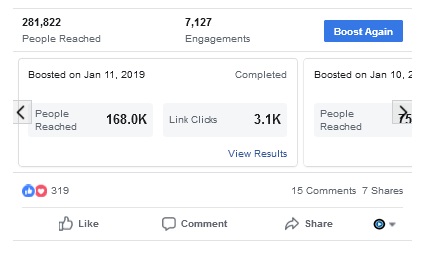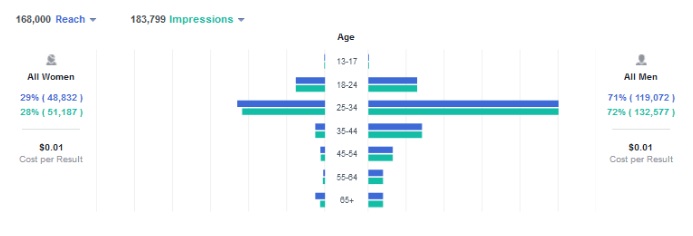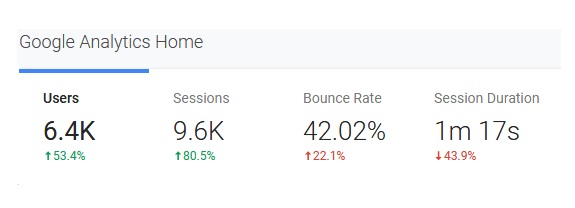
Over the past few months, several clients asked us to explain the “reach” that’s being reported in their social media campaigns, so we thought it was worth sharing this information with a wider audience.
Reach is a metric that was reported in advertising even before the advent of social media marketing. In advertising, reach is the total number of eyeballs in front of which the given ad, marketing piece, or a brand message displayed – in other words, the total number of people or households exposed to the ad campaign.
In terms of social media, reach is the broadest key performance indicator (or social engagement metric) for a specific social media campaign piece, such as a post, a video, or a photo.

The Facebook Ads Help Center
https://www.facebook.com/business/help/710746785663278 defines Reach as:
“The number of people who saw your ads at least once. Reach is different from impressions, which may include multiple views of your ads by the same people.”
This definition is quickly followed by a footnote pointing to the fact that: “This metric is estimated” – that means the total number does not come from hard numbers but rather from a sample of Facebook accounts to which the post in question has been served to.
Reporting Reach by Different Social Media Websites
While reach is most prominently displayed on Facebook, other social media platforms – like LinkedIn, Instagram, and Pinterest – also allow you to track this metric. Reach is conspicuously absent from Twitter’s reporting.
Keep in mind that different social media platforms calculate and report total reach in their advertising dashboards, so it’s smart to research each ad center before starting a new ad campaign. The different ways of calculating total reach in different platforms can also throw off your comparative analysis of social engagements generated by your campaigns run on different networks.
What is the difference between Reach and Impressions?
 Reach vs. Impressions – Visitors vs. Unique Visitors
Reach vs. Impressions – Visitors vs. Unique Visitors
Defining reach as the total number of people “reached” begs the question of how is that different from the number of total impressions. Reach is the number of people who saw your content. Impressions, on the other hand, is the number of times that your content has been displayed. It’s the same as the difference between “Visitors” and “Unique Visitors” in Google Analytics (since April of 2014 Google began to refer to those as “Sessions” and “Users”) or the Analytics section in your LinkedIn campaign.
 Organic, Paid, and Viral Reach on Facebook
Organic, Paid, and Viral Reach on Facebook
On Facebook, Reach can be further split into Organic Reach, Paid Reach, and Viral Reach.
Organic Reach is simply the number of people who saw your post displayed in their newsfeed. Paid reach is the number of times users came across your promoted content (Facebook ad or a boosted post). Viral Reach is the number of people who found your content because it was liked, commented on, or shared by people on their friend’s list.
How to Increase the Reach of my Social Media Content?
Increase Paid Reach
Increasing the paid reach is easy and usually means any combination of the following:
- Increasing the total budget.
- Broadening the targeting (geographical, demographics, etc.).
- Expanding the time-frame of the ad.
- Increasing per-view, per-click, or per-action bids.
- Adding more keywords, topics, interests.
Increase Organic Reach
To increase your organic reach, you can ask your existing followers base to share your post with people in their own networks (friends, family, etc.). You can also add incentives for subscribing to your content, sharing it, commenting, liking, etc. – this can be achieved by offering a prize, a discount code, etc. A safe bet would also be to share content created with marketability in mind: Look at your previous posts and find out what types of posts had the highest organic reach, were shared the most, generated the most likes, comments, etc. Usually, content that is funny, interesting, or eyebrow-raising gets the most likes, comments, and shares.
According to Scott Ayers (citing research from Marketo and Brian Carter) and his article “The 7 Secrets of Highly Shared Facebook Posts” published on Post Planner (
https://www.postplanner.com/7-secrets-of-highly-shared-facebook-posts/) the most shareable posts are those that: give, advise, warn, amuse, inspire, amaze, and unite.
Another good way to entice users to check out then share your content is to complement it with a video.
Increase Reach with Social Media Videos
Utilizing videos for social media posts can have a huge increase in shareability (read: increase reach) – by some estimates, the increase in shares can be as high as 1200% (Medium:
https://medium.com/@zipstrr/this-is-why-video-is-the-most-engaging-type-of-content-e5ca46d5cef1 )
Update (05.30.2023): How to increase reach on social media?
Here are 9 steps to increase your social media reach:
- Create engaging and shareable content: Craft compelling content that resonates with your target audience. It should be informative, entertaining, and visually appealing. Encourage sharing by including a call to action or creating content that sparks conversations.
- Utilize hashtags: Hashtags help categorize content and make it more discoverable. Research and use relevant hashtags in your posts to increase visibility to a wider audience. However, ensure that the hashtags are relevant and not excessive.
- Optimize posting times: Understand the peak activity times of your target audience on different social media platforms. Schedule your posts to align with these times to maximize reach and engagement. Experiment with different posting times to determine the optimal schedule for your audience.
- Engage with your audience: Actively respond to comments, messages, and mentions. Engaging with your audience builds trust and encourages them to share and interact with your content. Create conversations, ask questions, and encourage feedback to foster a sense of community.
- Collaborate with influencers: Identify influencers in your niche who have a significant following and engage with their audience. Collaborating with influencers can help expose your content to a larger and targeted audience, increasing your reach and credibility.
- Run social media contests or giveaways: Organize contests or giveaways that require participants to engage with your content by liking, sharing, or commenting. This strategy not only boosts engagement but also encourages participants to share your content with their network, expanding your reach.
- Use paid advertising: Consider investing in social media advertising to boost your reach. Platforms like Facebook, Instagram, and Twitter offer various advertising options that allow you to target specific demographics, interests, or behaviors, ensuring your content reaches the right audience.
- Cross-promote on multiple platforms: Share your social media content across different platforms to reach a wider audience. For example, if you have a YouTube channel, promote it on Instagram, Twitter, and Facebook, and vice versa.
- Analyze and optimize: Regularly review your social media analytics to understand which posts perform well and which ones don’t. Use this data to refine your content strategy and focus on what resonates with your audience.
People spend more and more of their online time watching videos. Marketers and advertisers shift more and more of their budget dollars towards creating and distributing videos online. Video content is the king of content nowadays, and this trend is expected to continue to expand into the foreseeable future, so if you haven’t yet, we encourage you to seriously consider developing video content for your social media campaigns. If you don’t know where to start, please feel free to visit the
social media video production section of our
website.
Need a Social Media Video Production Company? Contact Indigo Productions!
If you want to create compelling social media videos, and need a top-flight video production company to create your video content, please give us a call at
(212) 765-5224 or send us an
email via our contact us page.



